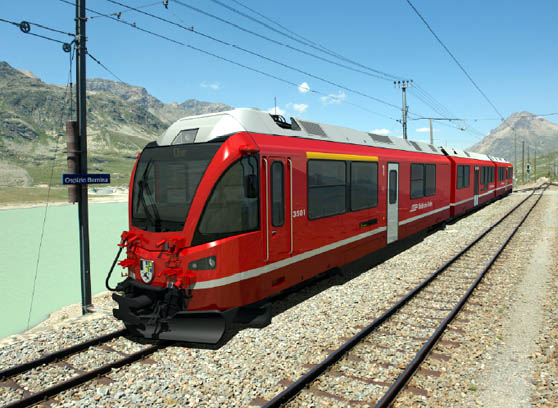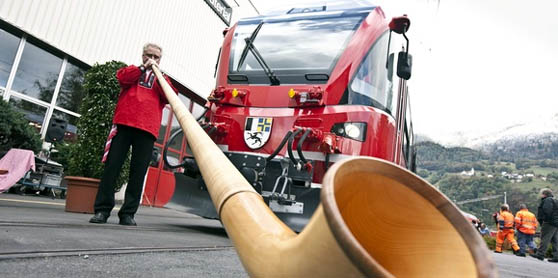
14 October 2009
The First New RhB Multiple Unit Train Rolls Out of the Factory

The new "ALLEGRA" series dual-voltage multiple unit train.
 Altenrhein Switzerland - 14 October 2009 will go down as a milestone date in the history of Rhätische Bahn (RhB), as this was the day when the first of 15 new "ALLEGRA" series dual-voltage multiple unit trains left the Stadler Altenrhein AG factory and was received to great celebration by RhB in Landquart. The remaining multiple unit trains will now be delivered and tested on the RhB network in stages, with the first five trains set to enter scheduled operation as of May 2010. These 15 state-of-the-art dual-voltage multiple unit trains will run on the Bernina line, the Chur-Arosa line, and the route between Landquart and Davos. This order is worth approximately 150 million Swiss Francs. In addition, a further five multiple unit trains have already been ordered for service in urban areas. These trains will be offering commuters within the Chur conurbation a much more comfortable journey from 2011 on. RhB is investing another 50 million Swiss Francs in this second stage of the project. The new multiple unit trains meet the needs and expectations of today's customer, they are comfortable, offer excellent disabled access, are air-conditioned, and feature passenger information systems. This can only serve to underpin RhB's competitive edge in the market. Altenrhein Switzerland - 14 October 2009 will go down as a milestone date in the history of Rhätische Bahn (RhB), as this was the day when the first of 15 new "ALLEGRA" series dual-voltage multiple unit trains left the Stadler Altenrhein AG factory and was received to great celebration by RhB in Landquart. The remaining multiple unit trains will now be delivered and tested on the RhB network in stages, with the first five trains set to enter scheduled operation as of May 2010. These 15 state-of-the-art dual-voltage multiple unit trains will run on the Bernina line, the Chur-Arosa line, and the route between Landquart and Davos. This order is worth approximately 150 million Swiss Francs. In addition, a further five multiple unit trains have already been ordered for service in urban areas. These trains will be offering commuters within the Chur conurbation a much more comfortable journey from 2011 on. RhB is investing another 50 million Swiss Francs in this second stage of the project. The new multiple unit trains meet the needs and expectations of today's customer, they are comfortable, offer excellent disabled access, are air-conditioned, and feature passenger information systems. This can only serve to underpin RhB's competitive edge in the market.

"ALLEGRA" rolls out of the Stadler plant.
Two Voltage Systems - One Type of Train
The first stage of Rhätische Bahn's fleet concept consists of purchasing 15 three-section dual-voltage multiple unit trains, worth around 150 million Swiss Francs. Stadler Altenrhein AG supplied RhB with the first such train on 14 Oct 2009. The first five trains will be delivered by April 2010 so, when the timetable changes in May of that year, they will make their debut on the Bernina line, helping to significantly relieve the strain on this section of the network, which is extremely busy during the summer months in particular. The railcars currently in service on the Bernina line, some of which are already quite old-fashioned specimens, no longer meet the expectations of modern passengers, nor can they cope with the levels of service they are now required to provide. Thanks to the flexible way in which they can be used, these dual-voltage multiple unit trains will also run on the Arosa line, as well as between Landquart, Davos, and Filisur.
A Real Powerhouse
The new dual-voltage multiple unit train not only has a really modern design, but on the inside it is also full of innovation and packs in a great deal of power. The drive equipment, which is capable of running on multi-systems, provides 2.6 MW of power (by way of comparison, the most powerful RhB locomotive, the Ge 4/4 III high-performance locomotive, provides 3.2 MW of power). Another impressive characteristic of the new multiple unit train is its high 260 kN tractive force at starting, which is actually 30% higher than that of the Ge 4/4 III. This makes the "ALLEGRA" a totally unique metre-gauge multiple unit train in terms of its power density, performance, and weight. RhB, Stadler, and the train's suppliers truly are breaking the mould here. The question of how to stow this power pack away in a restricted space underneath the railcar's floor presented a considerable technical challenge, after all, the space inside the multiple unit train had to be reserved for seating. But thanks to the concept which the team selected and the innovative way in which they implemented it, even this difficult goal was reached. The two railcars alone became home to 64 seats and eight folding seats.
The new multiple train units can even change their power supply system when moving. This means that in the future there will be no need to switch the traction vehicle in Pontresina between the main line and the Bernina line, which will result in even shorter journey times. State-of-the-art drive control and the single-axle drive ensure that the multiple unit trains can cope with the upward slopes of the RhB network even with heavy hauled loads and in all weather conditions. Peter Spuhler, proprietor and CEO of Stadler Rail Group, has this praise for the engineers involved in the project: "I am proud that we here in Switzerland have once again been able to build up such fantastic expertise in rail car construction. With this technology and spirit of innovation we really are playing in the Champions League."
The New Train Under the (rail) Paparazzi's Lens
The new "ALLEGRA" multiple unit train consists of two railcars and one intermediate car. The low-floor area of the intermediate car offers easy access to the train, a disabled WC (Water Closet, i.e. toilet), and space to store pushchairs. Bicycle storage facilities have also been provided in all three cars. In total, the multiple unit trains feature 24 first class and 76 second class seats, as well as additional folding seats and standing room. The passenger compartments are fully air-conditioned and equipped with a modern flat-screen passenger information system.
The new "ALLEGRA" multiple unit train stands out from the crowd not only in terms of modernity, comfort, passenger-friendliness, and safety, it also has a highly distinctive "look" from the outside. Its massive front wall bears an impressive depiction of the Bündner Wappen coat of arms. The ibex symbolises RhB's confidence in itself and its loyalty to the Grisons canton. The lower part of the driver's cab, which tapers to a point and features a driver's window which curves towards the back, gives the vehicle a touch of elegance. At the same time, the design manages to put across a feeling of the safety and power to be found in the new vehicle. There's no doubt that this new train will be much photographed and filmed, and not only by the huge numbers of railway enthusiasts out there.
The "Vrin" and "Vals" Interior Design Elements
The interior design of the new multiple unit trains is something quite special too, developing out of RhB's goal of being viewed as a strong Alpine scenic railway brand. The interior design picks up on local architectural traditions and puts a new spin on them - an approach which has brought the region's architecture to a global audience. In order to create a clear structure and to give the layout a feeling of space, two design themes were chosen to run through the entire train. The "Vrin" design, a modern interpretation of traditional timber constructions, has been used on the side wall liners throughout the whole train. These are broken up by the device boxes, which feature the "Vals" design, making them appear to be unevenly stacked blocks.
Focussing on the Customer
In future, the RhB fleet of trains designed for tourist transport will therefore be based on modern, air-conditioned trains with suitable disabled facilities and passenger-friendly information systems. Viewed against this backdrop, the delivery of the first multiple unit trains is a milestone in RhB's history. The chairman of RhB's board, Erwin Rutishauser, has this to say: "The new multiple unit trains are a huge leap forwards in terms of their technology and their design; they really chime with Rhätische Bahn's aim to be a modern, innovative, and customer-oriented company." The multiple unit trains (in both dual-voltage and single-voltage versions) are being purchased in several stages, so across large sections of the RhB network passengers will soon be able to enjoy a much more pleasant journey. The strategy being followed means that the oldest categories of traction vehicle and the oldest passenger carriages can be taken out of service, enabling refit costs to be avoided for the most part. In addition, the concept allows low-cost, existing rolling stock to be put into service for peak traffic periods in accordance with demand and the fleet to be significantly rejuvenated. Specifically, around 130 passenger carriages, some of which are over 60 years old, and 30 traction vehicles of the same age, are being taken out of service. Mr. Rutishauser says: "In this way, the procurement programme is helping to maintain the asset value of our rolling stock (which is an urgent priority), to the benefit of both holiday passengers and loyal commuters."
In Regular Service as of the 2010 Timetable
Before the first five multiple unit trains of the first phase of the project are put into scheduled service in the middle of May, there are still extensive test runs to be carried out on the Rhätische Bahn network. The first test runs involving RhB employees and their families have been pencilled in to take place following technical approval by the Swiss Federal Office for Transport (BAV), which is expected to be granted at the end of the year. The highlight will surely be the huge public ceremony held in Landquart to mark the official inauguration on 1 May 2010. Mr Rutishauser says: "We don't want to give anything more away about that just yet. However, it has already been confirmed that residents and guests from the whole of Grisons will be given the opportunity to travel to Landquart in the new multiple unit trains and to get to know the vehicles on short taster journeys."
The Next Stage: Five Trains for Loyal Commuters
In the second stage of the project, RhB's commuter trains, which are around 40 years old, will be replaced by five four-section single-voltage multiple unit trains. This will make the service offered to the public in the Churer Rheintal urban area (on the Chur - Thusis and Schiers - Rhäzüns lines) much more attractive and extensive. The order for these multiple unit trains has already been issued and they will be put into service in the spring of 2011. The five multiple unit trains will cost around 50 million Swiss Francs.
Investing in RhB's Future
Overall, therefore, the costs of the first and second stages of this project will run to approximately 200 million Swiss Francs. The finance for the fleet concept is being guaranteed by the cantonal and federal authorities, the equity market, and by releasing statutory reserves. Without the contribution of 22 million Swiss Francs provided by the cantonal authorities, the urgently needed replacement and associated rejuvenation of the rolling stock could not have been achieved so quickly.

Back |

